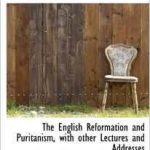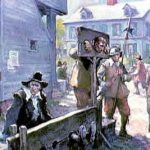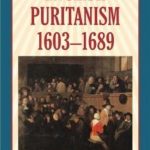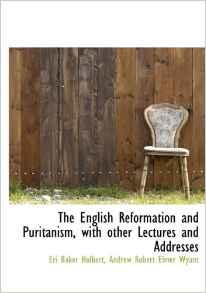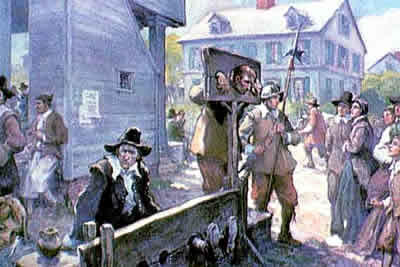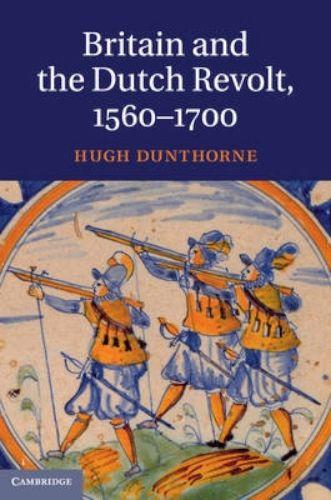As a reform movement, Puritanism had it roots in the earth-shaking German and Swiss reformations of Martin Luther, Ulrich Zwingli, and John Calvin.
These three religious figures spoke out against the papal abuse of authority and were in favor of a return to the biblical understanding of church and
church governance. King Henry VIII broke formal ties with the Roman Catholic Church because the papacy was unwilling to annul his marriage to
Catherine of Aragon, his Spanish wife, who had been unable to give him an heir. In 1534, the English Parliament, in the Act of Supremacy, established
the Church of England and appointed the king as the earthly head of the church.
Puritan was originally a derogatory term for sixteenth-century separatists from the Church of England, who called for greater purity in faith and politics;
they later adopted the name themselves. American Puritans founded their theocratic settlement as a modell of Christian charity. (New York Historical
Society, New York/Bridgeman Art Library)
Henry VIII died in 1547 and his son Edward took the throne. Archbishop Thomas Cranmer instituted church policy and oversaw spiritual matters in
England. Cranmer revised the prayer book, permitted clergy to marry, published a doctrinal statement called the Forty-Two Articles, and generally initiated
Protestant reform.
The death of King Edward VI in 1553 brought his half-sister Mary to the throne. A devout Catholic, she was determined to bring Roman Catholicism back
to England. For her brutality in dealing with Protestants who resisted her, she earned the nickname Bloody Mary. It is reported that in her reign she
martyred nearly 300 reformers, including women, children, and even expecting mothers. Archbishop Cranmer was burned at the stake on March 21,
1556. Many Protestants fled to the Continent, especially Geneva, and were influenced by Calvin’s preaching. After Mary’s rule came to an end in 1558
and her sister Elizabeth took the throne, these Protestants brought Calvin’s theology back to England.
Queen Elizabeth I tried to steer England’s religious life carefully between Romanism and Protestantism, in the tradition of King Henry VIII. This
ecclesiastical diplomacy is often called the Elizabethan Settlement. Elizabeth’s first order of business was to reinstate Henry’s Act of Supremacy and Act of
Uniformity in 1559. Elizabeth established herself as the only supreme head of the church and ordered the Book of Common Prayer, with a few
concessions for Catholics, back into worship services. Unfortunately, this only had the effect of alienating both religious groups. The Catholic Church
excommunicated her in 1570. It is at this point that we see the emergence of Puritans, who were protesting relics of Romanism still found in the Church
of England. In 1572, some anonymous Puritans circulated a document entitled Admonition to Parliament, demanding that England’s religious polity be
purified of all Romanism and established as Presbyterian, not Episcopalian. Elizabeth appointed Matthew Parker as Archbishop of Canterbury to suppress
the Puritan movement and maintain uniformity in her church. Elizabeth’s sovereign rule came to an end in 1603 and James I took the throne.
In 1604, King James I called the Hampton Court Conference to discuss the Church of England. James I had been raised a Presbyterian, but to everyone’s
amazement he was sympathetic to the Episcopalian form of church government because it elevated the king. This frustrated Puritan reformers; in
addition, by 1604, James I was requiring all pastors to subscribe to the Thirty-Nine Articles (a shortened version of the Forty-Two Articles). James I is
best known for having sponsored a leading English translation of the Bible, the King James Version in 1611. The first group of Puritan dissidents left
England in September 1620, sailing on the Mayflower to the New World in hopes of establishing a theologically and politically pure church.
Succeeding James I was his son, King Charles I. Charles I made William Laud Archbishop of Canterbury, and Laud re-established and enforced a fixed
standard of worship. Laud also initiated the Star Chamber, which suppressed the Puritans and the Calvinis doctrines. This was more than many Puritans
could bear, and a second group left for the Massachusetts Bay Colony in 1630. Laud and Charles I also attempted to impose their ecclesiastical
restrictions on the Scots. This inflamed the Scots’ Presbyterian sympathies. In 1638, they formed a National Covenant that pledged the Church of
Scotland to Presbyterianism. Civil War broke out in England in 1642 and eventually Charles I and the Church of England were defeated. Charles I was
executed in 1649. For a short time, Puritans were in control of church life in England. It was during this period that the Westminster Assembly of 1643
was convened by the Long Parliament to reform the Church of England by writing the Westminster Confession of Faith and the Westminster Catechisms.
Oliver Cromwell was thrust into the political spotlight by his army. Four years after Charles I’s death, Cromwell dismissed Parliament and made himself
Lord Protector of England. For a moment, a Puritan Commonwealth was firmly established in place of the monarchy. A group known as Triers was set up
by Cromwell to examine clergy for their fitness for the ministry. Cromwell governed the church for only seven years, until his death in 1658. Charles II
returned from exile in Ireland and restored the monarchy to England in 1660.
The Savoy Conference of 1661 was convened to rewrite the Book of Common Prayer. About twelve Anglicans and twelve Presbyterians, plus a handful of
assessors, met in vain to revise the text. Very few concessions were made, especially to Richard Baxter’s desire for an alternative service book and for
the ordination of Presbyterian ministers. In 1662, King Charles II sanctioned the fourth Act of Uniformity, which forever committed England to the Book of
Common Prayer and the Episcopal form of church government.
English Puritanism Photo Gallery
Maybe You Like Them Too
- Top 10 Islands You Can Buy
- Top 10 Underrated Asian Cities 2023
- Top 10 Reasons Upsizing Will Be a Huge Travel Trend
- Top 10 Scuba Diving Destinations
- The Best Cities To Visit in The World

